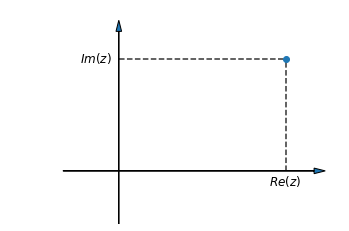Complex plane
Contents
Complex plane#
From the definition of complex numbers it is clear that there is a natural correspondence between a set of complex numbers \(\mathbb{C}\) and points in a plane: to every complex number \(z = x +iy\) we can uniquely assign a point \(P(x, y)\) in the \(\mathbb{R}^2\) plane. We call a plane in which every point has a corresponding complex number assigned to it a complex plane (or Argand plane). However, for simplicity we would normally simply say “in a point \(z\)” when we mean “in a point (of a complex plane) assigned a complex number \(z\).”
z = complex(3, 2)
fig = plt.figure()
ax = fig.add_subplot(111)
plt.plot(z.real, z.imag, 'o', zorder=10)
plt.plot([3, 3], [0, 2], '--k', alpha=0.8)
plt.plot([0, 3], [2, 2], '--k', alpha=0.8)
ax.text(2.7, -0.25, "$Re(z)$", fontsize=12)
ax.text(-0.7, 1.95, "$Im(z)$", fontsize=12)
ax.arrow(-1., 0, 4.5, 0, shape='full', head_width=0.1, head_length=0.2)
ax.arrow(0, -1.5, 0, 4, shape='full', head_width=0.1, head_length=0.2)
ax.axis('equal')
ax.set_xlim(-2, 4)
ax.set_ylim(-2, 4)
ax.axis('off')
plt.show()

Having represented complex numbers geometrically, let us revisit the terms we introduced in the first notebook.
Re \(z\) is equal to the abscissa and Im \(z\) to the ordinate of a point \(P\). We therefore call x-axis the real axis and y-axis the imaginary axis.
The modulus of a complex number \(|z|\) is equal to the distance between the corresponding point \(P\) and the origin of the complex plane. In general, the distance between points \(P_1\) and \(P_2\) assigned to numbers \(z_1\) and \(z_2\) is equal to the modulus of the difference of those two points:
If a number \(z\) is assigned a point \(P(x, y)\), then the complex conjugate \(z^*\) is assigned a point \(P^*(x, -y)\), which is just a reflection of \(P\) with respect to the real axis.
Every point \(P(x, y)\) has a corresponding vector \(\vec{OP}\) from the origin to \(P\). The sum \(z_1 + z_2\) therefore represents vector addition \( \overrightarrow{OP_1} + \overrightarrow{OP_2} \).
Because of the vector analogy, we can also say that complex numbers satisfy the triangle inequalities:
Trigonometric form#
We can also observe the complex plane in polar coordinates \((r, \phi)\) which are related to the Cartesian coordinates \((x, y)\) through:
This leads to the trigonometric form of a complex number \(z\):
where \(r\) is the modulus (or magnitude), equal to the absolute value of the complex number, a direct consequence of Pythagora’s theorem:
and the polar angle \(\varphi\) is defined (to a multiply \(2\pi\)) by:
The angle \(\varphi\) is called the argument (or phase) of a complex number \(z\) and we write \(\text{Arg}(z) = \varphi\). A special case is the complex number \(z=0\) for which \(r = 0\) and its argument is not defined.
Finding \(\varphi\) is delicate because \(\tan\) is a multivalued function. To avoid ambiguity, the simplest choice is \(n = 0\) so that the interval is of length \(2\pi\) and \( - \pi < \text{arg}(z) \leq \pi \). The value of \(\text{Arg}(z)\) with \(n=0\) is called the principal value of the argument. With this:
THe relationship between \(\text{Arg}(z)\) and \(\text{arg}(z)\) is therefore:
Multiplying two complex numbers results in their absolute values being multiplied and the arguments being added:
For the multiplicative inverse we have
Properties of \(|z|\) and arg(\(z\))
Let us summarise our findings in the form of the following equalities:
where \(z_1, z_2 \neq 0\). By induction we get:
Polar form#
The property \( \text{arg}(z_1 \cdot z_2) = \text{arg}(z_1) + \text{arg}(z_2) \) might remind us of logarithms, where \(\log (a \cdot b) = \log a + \log b\). This is not a coincidence!
The exponential function, which we will look at in the next chapter, allows us to write complex numbers in a polar form:
where we have used the Euler’s formula:
In this representation, certain operations become much easier. For example,
for all powers \(n \in \mathbb{Z}\). If we write this using a complex number with unit modulus we recover de Moivre’s formula:
Tip: Trigonometric identities
Trigonometric identities are also much easier to be recovered this way. For example, let us think about angle addition \(\theta + \varphi\).
We Apply Euler’s formula to each complex number.
Equate real and imaginary parts on both sides:
The reader is encouraged to try to recover other trigonometric identities.

